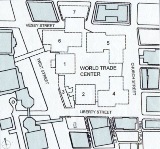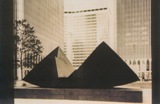International Foundation For Art Research (IFAR) www.ifar.org
This article may not be published or printed elsewhere without the express permission of IFAR
September 11th:
ART LOSS, DAMAGE, AND REPERCUSSIONS
Proceedings of an IFAR Symposium on February 28, 2002
Public Art at the World Trade Center
by Saul Wenegrat
[Saul S. Wenegrat is an Art Consultant and the former Director, Art Program, Port Authority of New York and New Jersey, which owns the World Trade Center. Mr. Wenegrat commissioned and curated the public art at the Center.]
I've had the good fortune of working with a great many important artists in the creation of public works for the World Trade Center (WTC), and I've had the horror of living through two tragedies which occurred at the Center: the 1993 bombing and the recent complete destruction on 9/11. I'd like to review with you what the public works were, who did them, and where they were located. Then I'll take you through what I found when I went down to the World Trade Center after the tragedy and bring you up-to-date on what is left of the works.
The commissioning process of public works, especially with a government agency such as the Port Authority, is very formal. You don't just go out and buy art. In 1969, as part of the planning of the World Trade Center, the Port Authority adopted a "percent-for-art" program allocating up to one percent of the construction costs to be spent for arts inclusion. It established an advisory group of knowledgeable persons in the arts, mainly from museums in the New York/New Jersey area, consisting of directors and curators of many of the leading institutions. This included Dorothy Miller of the Museum of Modern Art, Gordon Smith of the Albright-Knox Gallery in Buffalo, Sam Miller of the Newark Museum, Tom Messer, then Director of the Guggenheim Museum, and Tom Armstrong, then Director of the Whitney Museum. It also included knowledgeable lay people like Jane Engelhard. Basically, the Port Authority accepted their recommendations. The first art installation took place in the early 1970s; the last—a memorial for the 1993 bombing of the WTC—took place in 1995.
The following is a description of the art that was incorporated into the Trade Center and was in place on September 11, 2001:
At the Church Street entrance to the World Trade Center Plaza (Fig. I), there was a large, black Swedish granite sculpture by Japanese artist Masayuki Nagare (Fig. 2). It was completed in 1972 and measured 14 feet high by 34 feet wide by 17 feet deep. Although it looked like a solid piece, it was actually a veneer of granite over a steel and concrete armature.
Continue to page 2
